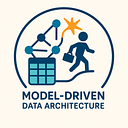Member-only story
Bringing the Semantic Layer Into a Model-Driven, Business-Friendly Data Architecture
From universal data models to GenAI-powered self-service analytics — how to integrate dbt’s semantic layer approach into a metadata-first way of working.
Summary
The promise: A semantic layer lets us define metrics and business logic once, centrally, and expose them consistently to dashboards, AI, and data apps.
The challenge: Most teams already pursue model-driven engineering, business-friendly mappings, and metadata governance — how does a new “semantic layer” fit in?
This article: Shows how to embed dbt’s semantic layer concept (MetricFlow) into a modern, model-first, metadata-driven data platform and turn it into a foundation for GenAI-enabled analytics.
💡 Not a Medium member? You can read this article for free using this friend link.
Why semantic layers matter
The original article by Abhishek Gupta explains how dbt’s semantic layer centralizes KPI and metric definitions, enabling governed self-service and freeing BI tools from duplicating logic.
Our platforms already emphasize:
- Model-driven data engineering — code-as-models, automated diagram generation, text-based mappings
- Business-friendly…

